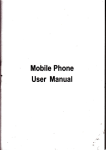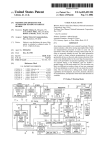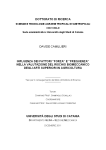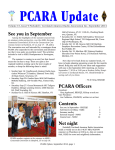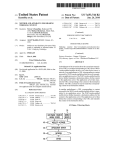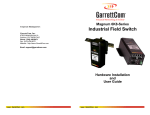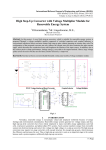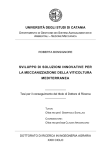Download Automated telephone line test apparatus with intelligent diagnostic
Transcript
US006438212B1 (12) United States Patent (10) Patent N0.: (45) Date of Patent: Lysaght et al. (54) (75) AUTOMATED TELEPHONE LINE TEST APPARATUS WITH INTELLIGENT DIAGNOSTIC FUNCTION OTHER PUBLICATIONS CMC 7910DX DataStar 386 Generic Users Manual, Com munications Mfg. Co., 1995. Dynatel 745 Subscriber Loop Tester Product Pro?le, Min nesota Mining and Manufacturing Co. (3M), 1996. 965 Subscriber Loop Analyzer (Speci?cations), 3M. Inventors: Robert J. Lysaght, Glen Ridge, NJ (US); Donald Finger, Peekskill, NY (US); Je?'rey Hahn, Greenwich, CT (US); Anthony M. Kolodzinski, Massapequa Park, NY (US); Howard Specialized Products Company (1988 Fall Catalog), pp. 128, 132, 133, 135. “The Front, A Hand—Held Computer”, Telephony, Sep. 19, Citron, South Salem, NY (US); 1988, pp. 24, 25. “Test Equipment, The Old & The NeW”, Teleconnect, 9/89, Yu-Ling Wu, Scarsdale, NY (US) pp. 78—90. (73) Assignee: Verizon Services Corp., Arlington, VA (Us) (*) Notice: US 6,438,212 B1 Aug. 20, 2002 “GTE’s NeW Line on Customer Service”, Datamation, May 1, 1990, pp. 68—70. Model T136BSB Circuit Test Set, Wilcom (Plantronics), Subject to any disclaimer, the term of this patent is extended or adjusted under 35 5/84. U.S.C. 154(b) by 0 days. Primary Examiner—Duc Nguyen Assistant Examiner—ReXford N Barnie (21) Appl. No.: 08/933,485 Sep. 18, 1997 (22) Filed: Int. c1.7 ............................................... .. H04M 3/08 (51) (52) US. Cl. ....................................................... .. 379/21 (58) Field Of Search ............................ .. 379/21, 22, 23, (74) Attorney, Agent, or Firm—Rader, Fishman & Grauer PLLC (57) A portable, automated telephone line test device includes a test module which applies test signals to a telephone line to 379/24, 25, 26, 27, 29, 30, 5, 6, 1, 1-01, be tested and detects electrical characteristics of the tele 12, 10-01, 22-02, 22-07, 27-01, 27-03, 27-04; 455/423; 364/528 (56) phone line, and a user interface module. The user interface module includes a microprocessor, a display, a keyboard and a program memory in accordance With a standard micro computer architecture. The processor of the user interface Refel‘ellces Cited U'S' PATENT DOCUMENTS 4,076,970 A 4,159,402 A 4,186,283 A : ABSTRACT module is programmed to control the test module to perform a pre-programmed sequence of tests. The display provides indications of the tests being performed. The programmed 2/1978 Lubarsky, Jr, et a1, 179/1752 R 6/1979 De GraauW et a1- -- 179/175-3 A sequence is varied by the device according to test results. Depending on the results obtained, the device also provides 1/1980 slmmonds ~~~~~~~~~~~~~~~~~ ~~ 379/21 interpretative diagnostic messages and instructs the user to 4,581,493 A 4/1986 Carry out additional test procedures 4,639,557 A 1/1987 Butler et a1. ................ .. 379/29 GaZZo et a1. ..... . . . .. 379/21 (List continued on next page.) 12 Claims, 9 Drawing Sheets 14 28\ / 30 "F to Test Module Communications ‘ Interface ‘ ;—— 22 18 _ Program Memory Micro-Processor i r A . Display Y 26 Keyboard > \ 24 W or k'In 9 Memory US 6,438,212 B1 Page 2 US. PATENT DOCUMENTS 5,208,846 A 5,241,277 A 4,670,898 A 6/1987 Pierce et a1. ................ .. 379/22 j?ggi?gig 2 $132; Burst“ 4,788,708 A “£1988 4’825’392 A 4/1989 4’837’811 A 4’843’62O A 4’92O’555 A 6/1989 Butler et 6/1989 Hagedom 4/199O lngalsbe 4,922,516 A “990 Butler et a1‘ 4 949 290 A 5,025,466 A 8/1990 Pike et al 6/1991 Hilligoss et a1‘ , , eta" Freeman ' ' ' ' ' ' ' ' 1/1992 Reum ~~~~~~~~~~~~ " 4/1992 Ackro? et al ’ . ' _ 379/6 379% 5,416,825 A 5/1995 Renger 61 a1. .............. .. 379/29 ' ' "564/550 5,432,705 A 7/1995 379/96 379/21 379/21 5,440,610 A 5,442,679 A 5,511,108 A * 8/1995 Schillaci et a1. .. 8/1995 Regis et a1. .... .. 4/1996 Severt et a1. .. 379m 5,528,661 A " 364/514 5,157,708 A 10/1992 379/21 5,170,114 A 5,195,124 A 12/1992 Lowenstein et a1. .. 324/128 3/1993 Ishioka ...................... .. 379/27 * Severt et a1. . 364/481 379/24 379/34 379/21 . 6/1996 S111 6161. ..... .. 379/27 * 4/1997 Chang et a1. .. 5/1997 Hincis et a1. .... .. 379/21 379/6 5,754,624 A 5/1998 Sullivan et a1. 379/21 5,799,060 A * 8/1998 Kennedy et a1. .. 379/29 5,619,489 A 5,629,628 A * 5 825 174 A .. . 324/538 4/1995 Kawaharata ................. .. 379/6 375/8 Gartwaite e161. .......... .. 5,410,585 A 379/28 6/1992 szymborski et al. Kefalas 23/921 364/580 379/1 . 5 081 670 A 5,121,342 A 8/1993 10/1994 Jung ___________ n * 5’1O5’438 A ’ 5 353 326 A , , 5/1993 Hammond et a1. ......... .. 379/15 * * 5’96O’O6O A * 7 7 * cited by examiner . 10/1998 Parker ...................... .. 374/106 9 1999 K .b 1 / a‘ e 379 21 """""""""""" " / U.S. Patent Aug. 20, 2002 Sheet 1 0f 9 1°\ US 6,438,212 B1 14 12 / “‘ User Interface Module Test Leads Test Module $ 16 Flg. 1 30 "F to Test Module Communications Interface 22 1 #7‘ 18 _ Program M emory ‘ Micro-Processor r 20 / A - Dlsplay Ke board y 26 \24 Working 1‘ Memory l U.S. Patent Aug. 20, 2002 ( Diagnostic Function \ US 6,438,212 B1 Sheet 2 0f 9 32 Selected Perform Ground 34 l Test Perform Voltage and Current Tests 58 Perform Current 2-wire Noise, Loss, Power Influence, Balance and Stress Tests Test For Shortsl Grounds / Detect Q Levels 69 66 Confirm Line No. 4 Perform Kick and Stress Tests I etected ? 64 Locate Fault 68 Report Results Fig. 3 End U.S. Patent Aug. 20, 2002 Sheet 3 0f 9 US 6,438,212 B1 /1 54 Perform Voltage and Current Tests 156 158 Preform 2-wire Loss and Circuit Noise Tests Functioning Line? 160 Test For T-R Short U.S. Patent Aug. 20, 2002 Sheet 4 0f 9 Dial Up US 6,438,212 B1 /102 Line l.D. Facility ‘ 110 Receive & Decode Dual Tone Multi-Freq. From 6.0. y /112 Retrieve Line No. From Memory 114 ‘ Compare with Line No. Data From C.0. Fig. 3B 104 Receive Number l.D. Request 106 Generate Dual Tone Multi-Freq. Corresponding To Requesting Line 108 ‘ Compare with Line No. Data From C.0. Fig. 3C 1 ‘ J U.S. Patent Aug. 20, 2002 US 6,438,212 B1 Sheet 5 0f 9 Loop Diagnostic Assistant -Job ID 268L001 42,» v0.6.0 rTicket Number 2079426298 "Test For AC Volts DC Volts Current Ground TR TC 2W_ireLoss ,NOISG Power 44 “T 48 Balance Stress x 46 —Messages .,52 ‘I gtart Up _ onnect the GREEN lead to up and BLACK lead to ground. Leave the RED lead (ring) off until you are instructed to connect it. ENTER=START TESTING ESC=QU|T F2=V|EW TEST RESULTS Loop Diagnostic Assistant -Ticket Number 268LD01 2079426298 "Test For AC Volts DC Volts Current Ground ZWireLoss ,_ Noise 44 v0.6.0 —Job ID TR 0.3V TC 0.4v -49.3v +0.5! +25.1mA RC— 0.5v -50.3v\_,~ 50 . 70dB Test Line 0.1dR 737-9963 19dB Power 50118 Balance 61 dB Stress 25dB 7“ 48 -— 46 —Messages Stress test complete. Net acceptable range: TR <30 dBrnc. yr,’ 52 No imbalance exists between Tip & Ring. : Test script complete: Choose what you want to do next. ENTER=RETEST LINE ESC=QUIT F2=VIEW TEST RESULTS U.S. Patent Aug. 20, 2002 Sheet 6 0f 9 US 6,438,212 B1 Loop Diagnostic Assistant -Job ID v1.2.0 -Ticket Number ‘ TEST#000003 9147394606 *Test For TR TC AC Volts EC Voltts urren Ground 2WireLoss 0.3V + 2é418.1X . m 0.4v RC 0.6V -0.3v -51.7v . 70dB ANI Dlaled: 5.1dB Phone Number: ,, guise ower 990 44 / Balance Stress 22dB -Messages The Circuit ID from the switch matches the subscriber’s phone number on the trouble/service order ticket. CID: 7394606 TN: 9147394606 ESC=STOP TESTING 08/22 01:36p Fig. 5A U.S. Patent Aug. 20, 2002 US 6,438,212 B1 Sheet 7 0f 9 Trouble found: Found unacceptable stress reading Accepted range is <30 dBmc one-sided fault (unbalance) exists. Test script complete Choose what you want to do next ENTER=START TESTING ESC=QU|T F2=V|EW TEST RESULTS Fig. 6 Loop Diagnostic Assistant -Job ID 268LD01 v1.2.0 -Ticket Number 2079426298 "Test For TC AC Volts *DC Volts \ 44 0,4v -0. v a . -0_5v Stress ‘ “Fault/Distance 68 ‘" : Coils: 48 W AWG Ft: OHMS: 100.00 EStFt: T 46 Sect: 1 “\ 70 —Messages Please enter the Temperature now: Underground cable typically is 50°F. I Aerial cable is at outside temperature unless extremely hot (above 90°F). the add 10°F to outside temperature reading. ESC=END CALCULATOR Ohms FAULT CALCULATOR 02/03 11:14a Fig. 7 Temp: 68 Coils: AWG: 26 AWG Ft: OHMS: 100.00 EstFt: N Mixed(Y/N) : 1176 Sect: Fig. 7A N U.S. Patent Aug. 20, 2002 TIME 10:40AM 10:26AM Sheet 8 0f 9 US 6,438,212 B1 JOB TICKET 268LD01 268LD01 "0hms” test(s) > > TC = 3500.0kQ RC = 3500.0KQ TROUBLE FOUND: Short circuit (Tip/Ring) appears to be the problem. Acceptable values are: TR, TC & RC: > 2800 K9 Distance to fault calculations will be done next: Fault/Calculator: Section = 1 Ohms = 100.00 V Temperature = 68 LoadCoilsX = 0 AWGMixed = N WireGaugeX = 26 OhmsFeet = 1176.00 Estimated distance to fault is 1176 feet ESC=QU|T UPIDOWN=SELECT SCROLL:PANUP/PANDN=PAGE UID=L|NE 02/03 11 :32a Fig. 8 Time 11 :00A Job Ticket N2DB2345 “Ground" Test(s) Ground Test Complete Found Good Ground. Met Acceptable range: TR > 70dBmc. “AC Voltage” Test(s) Found AC voltage acceptable. Acceptable values are: ESC=QUIT UPIDOWN=SELECT jCROLUPANU PIPAN DN=PAGE UID=LINE Fig. 9 U.S. Patent Aug. 20, 2002 Sheet 9 0f 9 Time 11 :00A Job Ticket N2DB2345 10:40A N2DB2345 US 6,438,212 B1 TR, T6 = R6 less than 5vAC “DC Voltage" Test(s) Found Little or no DC voltage. ESC=QU|T UPIDOWN=SELECT SCROLL:PANUPIPANDN=PAGE UID=L|NE Fig. 10 — TIME JOB TICK_ET 10:40AM 268L001 10:26AM 268LD01 —-—---_ l “Current Loop” Test(s) >TR = +2822 ma Loop current test completed Met acceptable range TR = 23-65 “2W Loss” Test(s) > “Test Line” 7-800-555-1212 Unable to get valid circuit loss reading Acceptable range is TR < 8.5dB Make sure the test line # is one. which generates a 1004 Hz tone. ESC=QU|T UPIDOWN=SELECT SCROLLIPANUPIPANDN=PAGE UID=LINE 02/03 11 :32a Fig. 11 US 6,438,212 B1 1 2 AUTOMATED TELEPHONE LINE TEST APPARATUS WITH INTELLIGENT DIAGNOSTIC FUNCTION test circuitry and for receiving test results from the test circuitry, a program memory connected to the processor, and a program stored in the program memory, the program causing the processor to cause the test circuitry to perform a ?rst one of the plurality of tests, and the program also causing the processor to select a second test from the FIELD OF THE INVENTION This invention relates to portable apparatus for use in plurality of tests on the basis of a result of a ?rst one of a testing telephone lines from subscriber locations. BACKGROUND OF THE INVENTION 10 It is knoWn to provide portable equipment to be used by telephone company technicians in trouble-shooting tele phone lines on Which trouble is reported. It is also knoWn to use microcomputer technology, including a keypad responsive processor and a processor-controlled display, to 15 aid the technician in using line-test equipment and as an programmed to receive data from the test circuitry indicative of a result of the test and, according to the result of the test, An example of portable line-test equipment Which employs microcomputer technology for input and output is to control the display to display a message instructing a user of the apparatus to perform a second test With respect to a the CMC 7910DX DataStar 386 terminal and test module (hereinafter “DataStar 386”), sold by Communications 25 reference. It is an object of the invention to provide a portable telephone line test device that is easier to use than prior art devices. It is a further object of the invention to provide a tele phone line test device Which automatically carries out a standardiZed sequence of tests. It is still a further object of the invention to provide a telephone line test device Which interprets results of tests connected to the processor and a program memory con processor further being programmed to receive data from the test circuitry indicative of a result of the test and, according to the result of the test, to control the display means to display a string of alphabetic characters Which informs a sources of line troubles on the basis of the test results. user of the apparatus of the result of the test. It is yet another object of the invention to provide a telephone line test device Which displays interpretive mes According to still a further aspect of the invention, there is provided an automated telephone line test apparatus Which includes test circuitry for applying test signals to a telephone line to be tested and for detecting electrical characteristics of sages and instructions to the user. SUMMARY OF THE INVENTION the telephone line, the test circuitry including a plurality of test leads for being selectively connected to the telephone 45 and a program memory connected to the processor, the play a message instructing a user of the apparatus to change a connection betWeen the test lead and the telephone line to be tested. The test apparatus provided in accordance With the inven tion carries out a complete and standardiZed trouble test circuitry for controlling the test circuitry, a display connected to the processor, and a program memory con nected to the processor, the processor being programmed to control the test circuitry so that the test circuitry performs a pre-programmed sequence of tests, the pre-programmed shooting operation Without relying on a high level of knoWl edge on the part of the test technician. An effective and 55 also being programmed to control the display such that the display provides a sequence of indications each correspond consistent diagnostic procedure is programmed into the apparatus. The test sequence is adapted according to the test results and the likely source of trouble indicated by the test ing to a respective test of the pre-programmed sequence of results. The technician is guided step by step through the test procedure and is provided With information that helps the tests, each indication being displayed While the correspond ing test is being performed. technician to understand the process carried out by the apparatus and the meaning of the test results. The technician According to another aspect of the invention, there is provided an automated telephone line test apparatus, includ ing test circuitry for applying test signals to a telephone line to be tested and for detecting electrical characteristics of the forming a plurality of tests that are different from each other, a processor connected to the test circuitry for controlling the line, a processor connected to the test circuitry for control ling the test circuitry, a display connected to the processor processor being programmed to control the display to dis teristics of the telephone line, a processor connected to the telephone line, the test circuitry having capabilities of per cable Which includes the telephone line to be tested. According to still another aspect of the invention there is provided an automated telephone line test apparatus Which includes test circuitry for applying test signals to a telephone line to be tested and for detecting electrical characteristics of the telephone line to be tested, a processor connected to the test circuitry for controlling the test circuitry, a display nected to the processor, the processor being programmed to control the test circuitry so that the test circuitry performs a test With respect to the telephone line to be tested, the performed by the device and automatically diagnoses sequence of tests being performed in accordance With a program stored in the program memory and the processor processor, the processor being programmed to control the respect to the telephone line; the processor further being ment. In accordance With the principles of the present invention, objects noted above and other advantages are realiZed by provision of an automated telephone line test apparatus including test circuitry for applying test signals to a tele phone line to be tested and for detecting electrical charac processor and a program memory connected to the test circuitry so that the test circuitry performs a test With interface for outputting information from the line-test equip Manufacturing Co., Los Angeles, California. The “Generic User’s Manual” for the DataStar 386, published by Com munications Manufacturing Co., is incorporated herein by plurality of tests. According to a further aspect of the invention, there is provided an automated telephone line test apparatus Which includes test circuitry for applying test signals to a telephone line to be tested and for detecting electrical characteristics of the telephone line, a processor connected to the test circuitry for controlling the test circuitry, a display connected to the receives comprehensive indications of the test results, and recommendations for corrective action. 65 BRIEF DESCRIPTION OF THE DRAWINGS The above and other features, advantages and aspects of the present invention Will become more apparent upon US 6,438,212 B1 3 4 reading the following detailed description in conjunction line to be tested is satisfactorily grounded. Block 36 in FIG. 3 indicates that the test procedure branches depending on Whether satisfactory grounding is found. If so, the apparatus proceeds to perform basic tests to determine Whether basic With the accompanying drawings in Which: FIG. 1 is a high-level block diagram of a test apparatus provided in accordance With the invention; functions are available in the telephone line to be tested FIG. 2 is a block diagram of a user interface module that (block 54) Speci?cally, standard tests are performed for AC is part of the apparatus of FIG. 1; FIGS. 3, 3A, 3C are How charts Which illustrate a soft Ware program for controlling a microprocessor that is part of the user interface module of FIG. 2; FIG. 3B illustrates operations at a central of?ce in con nection With an automatic line identi?cation function; and and DC voltage, and loop current. On the basis of these tests, it is determined Whether basic line function is present on the 10 telephone line being tested (block 56). If so, a sequence of transmission characteristic tests are performed (block 58). If at block 56 basic line function Was not found, then the procedure of FIG. 3 advances from block 56 to block 60, at Which tests are performed to detect hard shorts or grounds. FIGS. 4—11 illustrate various screen displays provided by In a preferred embodiment, these tests include detecting the user interface module of FIG. 2. 15 resistance levels among tip, ring and ground connections. Block 62 of FIG. 3 indicates that the procedure branches, DETAILED DESCRIPTION according to Whether a hard short or ground is detected With Apreferred embodiment of the invention is implemented respect to the tip and ring connections. If so, the location of the fault is determined (block 64). OtherWise, tests are as a softWare enhancement of a conventional device, such as the above-referenced DataStar 386 device. An overvieW of a suitable hardWare environment for implementation of the invention is provided by FIGS. 1 and 2. In FIG. 1, a test device 10 in accordance With the operation is shoWn to performed to gather more information about a “soft” fault or open circuit condition (block 66) Preferably these tests include a capacitive “kick” test and a stress test. In all cases, as indicated by block 68, results of the various tests are indicated on the display 26. include a test module 12 and a user interface module 14. The test module 12 has test leads 16 suitable for connection to tip, ring and ground sides of the telephone line to be tested. 25 The test module and user interface module may respectively correspond to the test module and terminal portions of the DataStar 386 device. It is also contemplated to integrate the test module and user interface module into a single unit. FIG. 2 illustrates salient components of the user interface Referring again to block 36, a ?nding of “bad ground” at that point leads the apparatus 10 to give the user the opportunity to reattach the ground lead to the telephone cable and to retest for adequate ground (block 38). If the user elects to do so, the procedure loops back to blocks 34 and 36. OtherWise, the procedure branches to a curtailed test sequence (FIG. 3A) in Which the apparatus only performs module 14, Which preferably is arranged in accordance With tests that can provide meaningful results in the absence of a standard architecture for a microcomputer. Included in the module 14 are a microprocessor 18, a Working memory 20 satisfactory grounding. In this case, as indicated by block associated With the microprocessor 18, a program memory 22 Which stores a program for controlling operation of the microprocessor 18, a keyboard 24 by Which a user provides 35 154 of FIG. 3A, the same voltage and current tests are performed as Were mentioned above in connection With block 54. Then, the procedure branches (block 156) accord ing to Whether basic line function is found. If so, block 158 folloWs, in Which the tWo-Wire loss and circuit noise tests are performed. PoWer in?uence, balance and stress tests are input to the microprocessor 18, and a display 26 by Which the microprocessor provides output to the user. Also included in the module 14 are an interface 28 through Which omitted, since valid results cannot be obtained Without good the microprocessor 18 eXchanges signals With the test mod ground. If at block 156 basic line function Was not found, a ule 12, and a communications interface 30 through Which the microprocessor 18 can exchange data With a remote After either of blocks 156 and 158, the test results are test for a tip-ring short circuit is performed (block 160). device such as a host computer. Operation of the apparatus 10 to perform telephone line trouble-shooting Will noW be discussed, initially With refer reported to the user (block 68, FIG. 3). 45 ence to FIG. 3. FIG. 3 illustrates in ?oW-chart form a program stored in the program memory 22 Which causes the apparatus to carry out an adaptive diagnostic test sequence. The diagnostic function illustrated in FIG. 3 may be selected by the user from a main menu (not shoWn) displayed on the display 26. Selection of the process of FIG. 3 from the menu is indicated at initial step 32 of FIG. 3. In response to selection of the diagnostic function, a screen display like that shoWn in FIG. 4 is provided by the display 26. The screen Referring once more to FIG. 3, after the sequence of tests represented by block 58 are performed, the apparatus carries out a procedure to con?rm, by machine-to-machine contact, that the telephone line that has just been tested matches the line indicated by the job assignment. This line con?rmation process is represented by block 69 in FIG. 3, and Will noW be described With reference to FIGS. 3B and 3C. 55 display of FIG. 4 includes a number of ?elds, including job Referring initially to FIG. 3B, the test apparatus requests identi?cation of the telephone line under test by dialing up a line identi?cation facility provided in the central office (block 102.). That is, the test apparatus couples onto the telephone line under test pre-determined dialing signals Which correspond to the telephone number (dialing no.) of ID ?elds indicated at 42, a ?eld 44 Which lists speci?c tests that may be carried out by the apparatus, and test result data ?elds 46, 48 and 50. Included at a bottom part of the display of FIG. 4 is a message ?eld 52. Upon initialiZation of the the central office line i.d. facility. These dialing signals are received at the central of?ce, Which treats the dialing signals as a request to identify the telephone line on Which the diagnostic function, the message in the message ?eld 52 instructs the user to connect some of the test leads 16 to dialing signals are received (block 104 FIG. 3C). The central of?ce then generates DTMF (dual tone multi-frequency) appropriate sides of the telephone line to be tested. The user can then initiate the diagnostic procedure. At the beginning of the diagnostic procedure, as indicated number) of the telephone line on Which the request Was at block 34 in FIG. 3, the test apparatus performs a test to determine Whether the cable Which contains the telephone signals Which represent the telephone number (dialing 65 received (block 106). The central of?ce couples the DTMF signals to the requesting telephone line for transmission to the test apparatus (block 108). US 6,438,212 B1 5 6 Referring again to FIG. 3B, the apparatus receives the DTMF signals transmitted from the central of?ce (block 110), and decodes the DTMF signals to produce data Which indicates the telephone number corresponding to the tele sequence of tests. Speci?cally, When the AC voltage tests is being performed, the “>” may be positioned adjacent the Words “AC Volts” in ?eld 44. When that test is complete, the indicator “>” Would be moved doWnWard so as to be adjacent to the Words “DC Volts”. The indicator “>” Would phone line under test. There folloWs block 112, at Which the be positioned adjacent the corresponding Words in FIG. 44 apparatus retrieves from memory 20 (FIG. 3) data Which identi?es the telephone number of the telephone line Which is the intended subject of the Work assignment (e.g., the as each test in the sequence is performed, concluding With telephone line on Which trouble Was reported). It Will be understood that the Work assignment data, including the 10 number of the line to be tested, had previously been stored before commencing the test procedure. The apparatus then compares the telephone number data retrieved from memory With the telephone number data obtained by decoding the DTMF signals from the central office, to con?rm that the line 15 actually tested Was the one intended to be tested according to the Work assignment. This machine-to-machine Work assignment con?rmation procedure represents an advance over prior art practice, in the Word “Stress” as the stress test Was being performed at the end of the transmission characteristic tests of FIG. 58. In addition, as results Were obtained for each of the tests, the ?elds 46, 48 and 50 Would be populated With corresponding test data obtained by carrying out the respective test. In addition, the progress through the sequence of tests is re?ected by verbal messages provided in the message ?eld 52. For example, When the AC voltage test has been com pleted and the DC voltage is being carried out, a message such as the folloWing may be displayed in the message ?eld 52: “AC Voltage tests complete. Met acceptable values: TR, TG & RG<5 vAC.” response, generated via speech synthesis by the central office In addition, the folloWing text may also be displayed: “DC voltage test noW being performed.” FolloWing is a sequence of messages displayed in the equipment, Which stated the line number of the tested line. message ?eld 52 as the sequence of tests proceeds through Which the test technician dialed up the central of?ce tele phone line i.d. facility, and then listened to an audible verbal The prior practice required the technician to match the number given by the machine-generated speech With the steps 54 and 58, and satisfactory results are found through 25 out. Work assignment data specifying the line intended to be tested. The machine-to-machine con?rmation procedure of Initially, after the ground test has been performed, the message displayed is: “Ground test complete. Found good ground. Met accept able range: TR<70 dBrnC. Connect the ring lead (red) FIGS. 3B and 3C relieves the technician of the effort of carrying out line i.d. con?rmation, While enabling the test apparatus to automatically store data con?rming that the line before continuing.” tested Was in fact the line Which Was the intended subject of Then, When the ring lead has been connected, the appa the test assignment. Further details of the program illustrated in FIG. 3 Will be understood from the pseudo-code listing annexed hereto as Appendix I, and from the script ?le printouts annexed hereto ratus performs the AC voltage test and on completing the test 35 as Appendix II. In addition, the folloWing discussion Will the following message is displayed: “AC voltage tests complete. Met acceptable values: TR, Then the DC voltage test Would be performed, and upon highlight aspects of the adaptive nature of the diagnostic functions of the test apparatus 10, and particularly the completion the folloWing message displayed: “DC voltage tests completed. Met acceptable values: TR guidance and information provided to the user by the apparatus. TEST SEQUENCE EXAMPLE—NO TROUBLE FOUND Initially, it Will be assumed that the telephone line to be tested is operating in accordance With prescribed speci?ca 45 tions in all respects. This may occur, for example, if there is an error in reporting trouble on the line, or if the line is being Since the voltage, current and ground tests all indicated acceptable readings, the tWo-Wire circuit loss test is per formed next. Upon completion of the test With acceptable and repair operation that has already been performed With respect to the telephone line. In any case, once the diagnostic function has been started, the ground, AC voltage, DC readings, the folloWing message is displayed. voltage and loop current tests are performed as called for by block 54 in FIG. 3. According to the present assumption, all of those tests indicate proper functioning of the telephone “Circuit loss test completed. Met acceptable range: 55 ing a tWo-Wire circuit loss test, a circuit noise test, a poWer in?uence test, a longitudinal balance test, and a stress test. It is to be understood that each of these individual test procedures is a standard test Which is Well knoWn to those TR<=20 dBrnC.” Then the poWer in?uence test Would be performed, and upon completion the folloWing message displayed: “PoWer in?uence test completed. Met acceptable range: of ordinary skill in the art, and therefore need not be described in detail. As the sequence of tests represented by TR<90 dBrnC.” The next test to be performed is the longitudinal balance blocks 54 and 58 is being performed, the apparatus provides test. Upon completion of that test, the folloWing message is to the user indications of What the apparatus is doing at any indication mark such as “>” in the test sequence ?eld 44 to indicate that the apparatus is progressing through the The next test is the circuit noise test. Upon satisfactory completion of this test the folloWing message is displayed. “Circuit noise test completed. Met acceptable range: mission characteristic tests represented by block 58, includ given time. For example, the apparatus may display an the loop current test, the folloWing message is displayed: “Loop current test completed. Met acceptable range: TR=23—65 mA.” tested to con?rm successful completion of a trouble shooting line, so that the apparatus proceeds to a sequence of trans As the above tests are completed, in addition to displaying the messages indicated above, the ?elds 46, 48 and 50 are populated in the appropriate roWs With data corresponding to the actual test results. The sequence of tests continues, and after completion of 65 displayed: “Longitudinal balance completed. Met acceptable range: US 6,438,212 B1 7 8 The ?nal test in the sequence is the stress test. Upon completion of this test, the screen display of FIG. 5 Would message, “Check for breaks in ground conduit.” Also, if the stress test carried out by the apparatus provides a marginal be provided. In the message ?eld 52, completion of the test reading, the apparatus displays the message: “One-sided fault (imbalance) may be forming. Check a good pair to see if stress reading is typical for this is indicated as Well as ?nding of acceptable results. It Will be noted that the ?elds 46, 48 and 50 have been fully populated area—marginal outside plant.” With data indicating the results of the tests that have been performed. It Will also be noted that, at the bottom of the message ?eld 52, the user is advised that the test sequence has been completed and the user’s options are presented. FIG. 5A is a screen Which indicates that the apparatus has As another example, if the “kick” test performed as part of block 66 (FIG. 3) indicates a tWo-sided open condition, the user is instructed: 10 performed the automatic line number con?rmation proce dure described above in connection With FIGS. 3B and 3C. condition. The stress test Will be done next, to test for electrical balance.” It has been noted above that, during the course of the test EXAMPLES WITH TROUBLE FOUND If during the sequence of tests an unacceptable reading is found, a corresponding message is provided in the message ?eld 52. An example of such a message is shoWn in FIG. 6, Which shoWs the message provided When the stress test results in an unacceptable reading. Other messages indica tive of unacceptable conditions are listed in Appendix II. As has been discussed above, if basic line function is not found at steps 54 and 56 (FIG. 3), testing for a hard fault takes place. FIG. 7 illustrates a screen display provided “Check a good pair to verify kick values indicate an open sequence carried out by the apparatus, the apparatus 15 instructs the user to change the con?guration of the connec tion betWeen the test leads and the line being tested. For example, after detection of adequate ground, the user is instructed to connect the ring lead to the ring side of the line. HoWever, according to another embodiment of the invention, the user may be instructed to connect all three test leads respectively to tip, ring and ground at the beginning of the test sequence. This embodiment is further provided With suitable relays or other sWitches in the test module that are controlled to effectively control connection or disconnection When a hard fault is found. The tests for Which unacceptable 25 of the lead Within the test module. readings Were obtained are marked With an asterisk in ?eld It should also be noted that, in a preferred embodiment of 44 (in this example the “DC Volts” and “Ohms” test entries are so marked) and entries in ?elds 46, 48 and 50 indicative of readings outside of the acceptable range are highlighted. the invention, the apparatus displays a reminder to the user that When a neW line is to be tested, the test leads must be disconnected from the previous line and connected to the (In this example, the highlighted out-of-range data are the neW line. entries in ?eld 46 (tip-ring) corresponding to the DC volts and Ohms tests, and the entry in ?eld 50 (ring-ground) corresponding to the DC volts test.) If a hard fault is found, an additional ?eld 70 collects the data required to calculate the distance to the fault. Amessage in ?eld 52 prompts the user to enter the required data. The “coils” entry is for indicating Whether load coils are present on the cable. A pop-up list (not shoWn) prompts the user to 35 trouble on the basis of test results. The apparatus also keeps the technician informed as the test sequence proceeds, test results are obtained, and diagnostic conclusions reached. enter the number of load coils. Entries for the Wire gauge are also provided. Based on the entered data, an estimated distance to the fault is calculated and displayed, as shoWn in FIG. 7A. The user also has the option to change some of the The technician is provided With step-by-step guidance as to actions needed to continue the test procedure and With recommendations for remedial actions. The apparatus is programmed to provide consistent and effective trouble shooting procedures Which make ef?cient use of the tech parameters and have the distance calculation repeated. When the test sequence is complete, the user is permitted to direct the apparatus to retest the line. Alternatively, the nician’s time and minimiZe callbacks on trouble reports. 45 user may vieW the test results obtained, or may exit from the FIG. 8 shoWs an example of a screen display provided When the user elects to vieW test results. In this case, it is assumed that a hard fault (tip-ring short) has been found and of previously determined test results in Which acceptable computer from the portable line-test apparatus. The uploaded data may include a list of the tests for Which satisfactory and unsatisfactory results Were founded, as Well as the actual test data Where the results Were unsatisfactory. 55 results are shoWn. The screen display of FIG. 10 may be reached by scrolling doWn from the display of FIG. 9. In the example shoWn in FIG. 10, a lack of DC voltage is indicated. FIG. 11 is another example of a screen vieWable through the “vieW test results” option. In this case, the tWo-Wire circuit loss test resulted in an unacceptable reading. Another notable feature of the present invention resides in instructions provided by the apparatus to the user to engage in additional tests in certain circumstances. For example, if the ground test carried out by the appa ratus fails to ?nd good ground, the apparatus displays the Also, in accordance With conventional practice, the por table line-test apparatus may be connected by telephone line With a central administrative computer, so that job assign ment data may be doWnloaded to the apparatus from the central computer. In addition, test result data and other reports on jobs performed can be uploaded to the central automated diagnostic function. the estimated distance to fault calculated. FIGS. 9, 10 and 11 are other examples of screen displays provided in response to the selection of the “vieW test results” function. FIG. 9 illustrates an initial screen display The portable telephone line testing apparatus disclosed herein provides signi?cant advantages in terms of aiding telephone technicians in the performance of line trouble shooting operations. The apparatus provides automated selection and sequencing of test procedures and diagnosis of Also, the data uploaded by the apparatus may include a con?rmation that the line number provided by the central of?ce during the procedure of FIGS. 3B and 3C matched the number of the line speci?ed in the Work assignment. If there Was not a match, the number of the line actually tested may be reported. In all cases it is understood that the above-described arrangements are merely illustrative of the many possible speci?c embodiments Which represent applications of the 65 present invention. Numerous and varied other arrangements can be readily devised in accordance With the principles of the present invention Without departing from the spirit and scope of the invention. US 6,438,212 B1 9 10 What is claimed is: tests has one or more of a voltage test and a loop current test 1. An automated telephone line test apparatus, compris on said line to be tested to determine if said line to be tested ing: test circuit means for applying test signals to a telephone line to be tested, and for detecting electrical character istics of said telephone line to be tested; is functioning, and if said line to be tested is determined to be functioning, said branch of subsequent tests further has a 5 tWo-Wire circuit loss test and a circuit noise test circuit, and one or more of a poWer in?uence test, a longitudinal balance test and stress test on said line to be tested; and When said a processor connected to said test circuit means for ground test indicates a failure to ?nd a good ground, said controlling said test circuit means; display means connected to said processor; and a program memory connected to said processor; said 10 processor being programmed: to control said test circuit means such that said test circuit means performs a pre-programmed sequence of a plurality of different tests With respect to said telephone line to be tested, said pre-programmed sequence of a plurality of different tests being per formed in accordance With a program stored in said program memory; to control said display means such that said display means provides at the start of said performance of said pre-programmed sequence of tests a display having a ?rst ?eld in Which alphabetic information identifying each of said plurality of different tests is together listed and a second adjacent ?eld in Which the results of said tests are to be displayed and as if said line to be tested is functioning, and if said line to be tested is determined to be functioning, said branch of subsequent tests further has a tWo-Wire circuit loss test and a circuit noise test on said line to be tested. 6. An apparatus according to claim 4, Wherein said test 15 being performed is one or more of a voltage test and a loop current test on said line to be tested, and: if said test being performed indicates a functioning line, said branch of sub sequent tests has a tWo-Wire circuit loss test and a circuit noise test and one or more of a poWer in?uence test, a longitudinal balance test and stress test on said line to be tested; and if said test being performed indicates a non functioning line, said branch of subsequent tests has an ohms test on said line to be tested to determine a fault on the line to be tested, and if a fault is not determined on the line to be 25 tested, said branch of subsequent tests has one or more of a capacitive kick test and a stress test on the line to be tested. testing proceeds to further control said display means to provide for each test: in said ?rst ?eld adjacent the 7. An apparatus in accordance With claim 4, Wherein said test being performed is an ohms test on the line to be tested to determine a fault on the line to be tested, and if said test being performed indicates: a fault has not been detected on the line to be tested said branch of subsequent tests has one listing of the corresponding test and during the performance of the test a display of an indication that the test is being performed; and in said second ?eld a display of the numeric readings of the results of the or more of a capacitive kick test and a stress test on the line test. to be tested. 2. An apparatus according to claim 1, in Which said plurality of different tests Which are listed in said ?rst ?eld include at least an AC voltage test, a DC voltage test, a loop branch of subsequent tests has one or more of a voltage test and a loop current test on said line to be tested to determine 8. An automated telephone line test apparatus, compris 35 ing: test circuit means for applying test signals to a telephone current test, a ground test and a tWo Wire current loss test. line to be tested, and for detecting electrical character istics of said telephone line to be tested; 3. An apparatus according to claim 2, in Which said plurality of different tests Which are listed in said ?rst ?eld further includes a circuit noise test, a poWer in?uence test, a longitudinal balance test and a stress test. a processor connected to said test circuit means for 40 4. An automated telephone line test apparatus, compris ing: controlling said test circuit means; display means connected to said processor; and a program memory connected to said processor; test circuit means for applying test signals to a telephone line to be tested and to a cable containing the telephone 45 said processor being programmed: to control said test circuit means so that said test circuit means performs a test With respect to said telephone line to be tested; to receive data from said test circuit means indicative of a result of said test; and according to said result of said test, to control said display means to display a message instructing a user of the apparatus to perform a second test With respect to a cable Which includes said telephone line to be tested. line to be tested, and for detecting electrical character istics of said telephone line to be tested and said cable, said test circuit means having capabilities for perform ing a plurality of tests that are different from each other; a processor connected to said test circuit means for 50 controlling said test circuit means, and for receiving test results from said test circuit means; a program memory connected to said processor; and a program stored in said program memory, said program for controlling said processor to cause said test circuit 55 means to selectively perform said plurality of tests; and said program being adapted to cause for each of one or more of said plurality of tests being performed on the basis of a result of the test being performed said 9. An automated telephone line test apparatus, compris ing: test circuit means for applying test signals to a telephone line to be tested, and for detecting electrical character istics of said telephone line to be tested; a processor connected to said test circuit means for processor to only branch from the test being performed to subsequent tests of said plurality of tests Which Will provide meaningful test results, said test circuit means branching to said subsequent tests responsive to said controlling said test circuit means; display means connected to said processor; and processor. said processor being programmed: 5. An apparatus according to claim 4, Wherein said test being performed is a ground test on said cable and When: said test indicates a good ground, said branch of subsequent a program memory connected to said processor; to control said test circuit means such that said test circuit means performs a test With respect to said telephone line to be tested, US 6,438,212 B1 11 12 to receive data from said test circuit means indicative of a result of said test; and operating the test module to carry out a sequence of tests With respect to said telephone line in response to said stored program, said sequence of tests automatically branching on the basis of respective results of said according to said result of said test to control said display means to display a message instructing a user of the apparatus to perform a second test With respect to a cable Which includes said telephone line, said second test being a test With respect to a Wire pair other than a Wire pair corresponding to said tele phone line to be tested. tests; displaying a message instructing a user of the testing device to perform a test With respect to a cable Which contains said telephone line to Which said test module 10. An automated telephone line test apparatus, compris is connected; and ing: test circuit means for applying test signals to a telephone line to be tested, and for detecting electrical character istics of said telephone line to be tested; a processor connected to said test circuit means for controlling said test circuit means; 15 display means connected to said processor; and a program memory connected to said processor; said processor performing said test With respect to the cable. 12. A method of testing a telephone line utiliZing a portable test device, said test device including a test module connected to said telephone line, a microprocessor for controlling the test module, and a memory storing a program for controlling the microprocessor, the method comprising the steps of: being programmed: to control said test circuit means so that said test circuit operating the test module to carry out a sequence of tests means performs a test With respect to said telephone line to be tested; to receive data from said test circuit means indicative of a result of said test; and according to said result of said test, to control said With respect to said telephone line in response to said stored program, said sequence of tests automatically branching on the basis of respective results of said tests; and displaying a message instructing a user of the testing display means to display a string of alphabetic char 25 acters Which informs a user of the apparatus of said device to perform a test With respect to a cable Which result of said test, said string of alphabetic characters contains said telephone line to Which said test module including a verbal message stating to the user that the test result is one of Within a range of acceptable values and not Within a range of acceptable values. 11. A method of testing a telephone line utiliZing a portable test device, said test device including a test module connected to said telephone line, a microprocessor for controlling the test module, and a memory storing a program for controlling the microprocessor, the method comprising the steps of: is connected; performing said test With respect to said cable; and prior to said performing step, connecting said test module to a Wire pair contained in said cable, said Wire pair being different from a Wire pair corresponding to said telephone line.

















